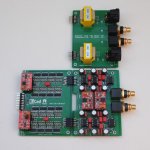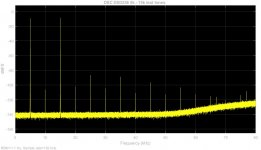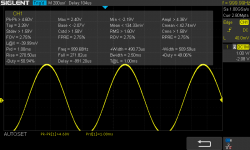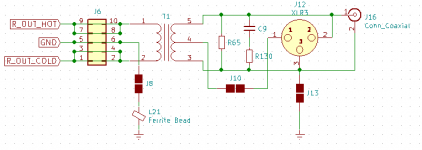I'd recommend to try different HQP filters to decide what you like most.
IMHO poly-sinc-xtr or closed-form in DSD256 is better than poly-sinx-xtr-2s and closed-form-fast in DSD512.
If you are unlucky like me and you will fall in love with closed-form or poly-sinc-xtr:
1. for closed-form you will need high-speed DDR4. Even i7-8700 with DDD4-2133 can't handle it (without CUDA offload). I succeed only with DDR4-3666 at AMD platform (Intel is faster with RAM, perhaps for Intel DDR4-3400 or even less is enough).
2. for poly-sinc-xtr you will need a lot of L2 CPU cash. This is the main reason why I can't get poly-sinc-xtr DSD512 at i7-8700. DSD256 worked quite well.
Don't be in a hurry. Try money-back with local shop, if possible.
Thanks,
i canceled i7 4790K from ebay, i will try to be patient and wait for DSC2
maybe Ryzen processor...
Does anyone have a general manual and/or guide for the original DSC1 (2016.07.20)?
I just got two TPS7A4700 Low Noise RF Power Modules.
"Basic parameters: Max 20V, Max 1A (dynamic power, high current, pay attention to heat), the output on-demand settings."
I should have everything I need now in terms of hardware.
I was hoping to get a link to a good build log, if anyone have any to recommend. BTW, if there is no official manual, any documentation you all know of would be appreciated.
I did find this which contains some good info, but not exactly what I was looking for.
PureDSD
Thanks!
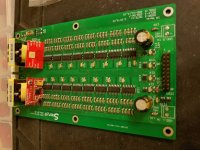
I just got two TPS7A4700 Low Noise RF Power Modules.
"Basic parameters: Max 20V, Max 1A (dynamic power, high current, pay attention to heat), the output on-demand settings."
I should have everything I need now in terms of hardware.
I was hoping to get a link to a good build log, if anyone have any to recommend. BTW, if there is no official manual, any documentation you all know of would be appreciated.
I did find this which contains some good info, but not exactly what I was looking for.
PureDSD
Thanks!

Last edited:
One more beginner question : The dac is built and all I have left to do is to wire up the output RCA's. My version is the Chinese balanced output board with the 600:600 ohm transformers (10k ones are on their way). I want to convert the balanced output to single ended and read that I need to connect the -ve phase to ground and the positive phase to rca +ve , ground is connected to rca negative.
Would come kind soul let me know if this is correct.
Thanks in advance ,
Gordon
Would come kind soul let me know if this is correct.
Thanks in advance ,
Gordon
Since Pavel is fully in DSC production now, I'll try to answer some questions. Of course, Pavel correct me if necessary. 
There was a quite big discussion at Russian Signalyst DSC thread about the need of I/V converter. I think in that particular case shift registers form a simple voltage divider. That’s why I/V stage isn’t needed. It’s only my IMHO.
Pavel tried discrete output of his own design too. It was worser then transformer output stage. That's why lately he focus only at transormers output stage.
Frequency response of stock DSC v2 transformers 10 Hz - 150 kHz +/- 0.2 dB. That's why there is practically no LPF in DSC v2 from my point of view. In attach you can see DSC 2.5 measurements 5K+15K signal (DSD256). I have no problem with ultra sonic noise with my Prima Luna Dialog Premium amp and DTQWT by Troels Gravesen.
Output voltage 1.6V Rms. Zout ~ 700Ohm.
I understand the DSC V2 is a current output dac which requires an I/V stage to convert the output current into voltage, and you need a low pass filter to get rid of the ultrasonic noise. .......
So my question is whether you also tried discrete / non-transformer output stages ? ........
Does PCM require the same type of LPF filter as your DSC V2 DSD dac? Or is a output stage for a DSD dac different from a PCM dac?
There was a quite big discussion at Russian Signalyst DSC thread about the need of I/V converter. I think in that particular case shift registers form a simple voltage divider. That’s why I/V stage isn’t needed. It’s only my IMHO.
Pavel tried discrete output of his own design too. It was worser then transformer output stage. That's why lately he focus only at transormers output stage.
Frequency response of stock DSC v2 transformers 10 Hz - 150 kHz +/- 0.2 dB. That's why there is practically no LPF in DSC v2 from my point of view. In attach you can see DSC 2.5 measurements 5K+15K signal (DSD256). I have no problem with ultra sonic noise with my Prima Luna Dialog Premium amp and DTQWT by Troels Gravesen.
what would be the output voltage and impedance of this version of DSC-2 with transformers?
Output voltage 1.6V Rms. Zout ~ 700Ohm.
Attachments
OK...
Thanks for this info. So it appears that a preamp is really necessary with this circuit, or to add an active buffer stage with a bit of gain. My amplifier options are going to want more voltage and lower impedance for best performance. Would it be appropriate to discuss possible gain stage options here, or in another thread?
Since Pavel is fully in DSC production now, I'll try to answer some questions. Of course, Pavel correct me if necessary.
There was a quite big discussion at Russian Signalyst DSC thread about the need of I/V converter. I think in that particular case shift registers form a simple voltage divider. That’s why I/V stage isn’t needed. It’s only my IMHO.
Pavel tried discrete output of his own design too. It was worser then transformer output stage. That's why lately he focus only at transormers output stage.
Frequency response of stock DSC v2 transformers 10 Hz - 150 kHz +/- 0.2 dB. That's why there is practically no LPF in DSC v2 from my point of view. In attach you can see DSC 2.5 measurements 5K+15K signal (DSD256). I have no problem with ultra sonic noise with my Prima Luna Dialog Premium amp and DTQWT by Troels Gravesen.
Output voltage 1.6V Rms. Zout ~ 700Ohm.
Thanks for this info. So it appears that a preamp is really necessary with this circuit, or to add an active buffer stage with a bit of gain. My amplifier options are going to want more voltage and lower impedance for best performance. Would it be appropriate to discuss possible gain stage options here, or in another thread?
Thanks for this info. So it appears that a preamp is really necessary with this circuit, or to add an active buffer stage with a bit of gain. My amplifier options are going to want more voltage and lower impedance for best performance. Would it be appropriate to discuss possible gain stage options here, or in another thread?
I guess it'll depend on your specific context; I'm getting great results with my current DSC2 (V2.6.0) straight into my scratch built Transcendent 300B SE-OTL amps. I will at some point try a tube buffer stage between them just to find out...
Last edited:
I guess it'll depend on your specific context; I'm getting great results with my current DSC2 (V2.6.0) straight into my scratch built Transcendent 300B SE-OTL amps. I will at some point try a tube buffer stage between them just to find out...
@nautibuoy what can I say... I also have 300B SE.
Do you go straight to the amp without transformers?!
@nautibuoy what can I say... I also have 300B SE.
Do you go straight to the amp without transformers?!
Off topic but what derivative of the Transcendent 300B SE-OTL do you have? My build uses the alternative output stage where each of the four 300Bs has its own current sink and very special DC filament supply, summed at the output and, of course, no output transformers.
Anyway, I have a previous verson of Pavel's DSC2 with the Chinese transformers. I take the single-ended output from the board (so after the transformers) direct into the 300B SE-OTL inputs and use the HQP volume control. I initially used a temporary passive attenuator as an insurance policy but once I gained confidence that everything was behaving consistently I removed it, though I do have a pair of Slagle autoformer attenuators I'm looking to install in the amps for greater convenience.
Output voltage 1.6V Rms. Zout ~ 700Ohm.
Thanks Vit for your replies! Can I ask, output voltage 1.6V is for RCA and 3.2V for balanced? Thanks !
Hi guys , got my build up and running and tested it with the CD transport last night : big improvement over my previous dual 4495 build from the same chinese manufacturer (Ustars).
This morning I flashed the Anamero board with CLPD 1080 and CPU 1099c ,installed drivers for the card on win10 pc running Jriver. The card shows up in usb output devices in Jriver but I was getting "Jriver can not out files to you device in 44.1khz" format. Tried Wasapi and KS and these both appear to play but there is no sound from the speakers.
I reflashed the card with the CLPD 1080 slave firmware and the situation was the same except now the SRC indicator light is coming on as it did with the cd transport. The display on the dac either shows not locked or 'Other' when the usb board is selected.
I have done a number of searches on this forum and net wide through google but haven't found an answer yet.
I do have a Singxer XMOS f1 board I could try but would rather try to get the Amanero board working first.
Anyone have any ideas?
Thanks in advance,
Gordon
This morning I flashed the Anamero board with CLPD 1080 and CPU 1099c ,installed drivers for the card on win10 pc running Jriver. The card shows up in usb output devices in Jriver but I was getting "Jriver can not out files to you device in 44.1khz" format. Tried Wasapi and KS and these both appear to play but there is no sound from the speakers.
I reflashed the card with the CLPD 1080 slave firmware and the situation was the same except now the SRC indicator light is coming on as it did with the cd transport. The display on the dac either shows not locked or 'Other' when the usb board is selected.
I have done a number of searches on this forum and net wide through google but haven't found an answer yet.
I do have a Singxer XMOS f1 board I could try but would rather try to get the Amanero board working first.
Anyone have any ideas?
Thanks in advance,
Gordon
Use the guide from the overview Andrea Ciuffoli JRiver + ASIO ProxyThis morning I flashed the Anamero board with CLPD 1080 and CPU 1099c ,installed drivers for the card on win10 pc running Jriver. The card shows up in usb output devices in Jriver but I was getting "Jriver can not out files to you device in 44.1khz" format. Tried Wasapi and KS and these both appear to play but there is no sound from the speakers.
This XMOS does not have a MUTE signal. Caution, you can damage your hearing! There will be very loud popup clicks when switching DSD <-> PCM.ozca said:I do have a Singxer XMOS f1 board I could try but would rather try to get the Amanero board working first.
Anyone have any ideas?
Use the guide from the overview Andrea Ciuffoli JRiver + ASIO Proxy
This XMOS does not have a MUTE signal. Caution, you can damage your hearing! There will be very loud popup clicks when switching DSD <-> PCM.
Hi Pavel , should have mentioned I am using the AK4137 board to do the upsampling. Do I still need Asio proxy.
Did I do the right thing in using clpd 1080 slave rather than just clpd 1080 , neither way results in any output?
Thanks Vit for your replies! Can I ask, output voltage 1.6V is for RCA and 3.2V for balanced? Thanks !
No, for balanced 1,6 Vrms too.
Here is a schematic of output module of DSC 2.5.2 with stock transformers.
Attachments
Use the guide from the overview Andrea Ciuffoli JRiver + ASIO Proxy
This XMOS does not have a MUTE signal. Caution, you can damage your hearing! There will be very loud popup clicks when switching DSD <-> PCM.
Yes, true. XMOS U208 makes very loud POP sound.
Because of this problem i have blown tweeter in my vintage Cizek speakers, which causes heat in crossover and almost fire inside speaker.
XMOS has also more noise than Amanero, with NoDAC connection.
My temp setup was CPU, XMOS U208, RC filter, C coupling, LDR volume control with NSL-32SR3, Dartzeel NHB-108 copy without servo and input capacitor, Cizek model 3.
Yes, true. XMOS U208 makes very loud POP sound...
Has any of you tried JLsounds I2SoverUSB board?
Has any of you tried JLsounds I2SoverUSB board?
Or Amanero with Crystek CCHD-957?
I've just bought Amanero with Crystek CCHD-957  . In 3-4 weeks I'll give a full report.
. In 3-4 weeks I'll give a full report.
Amanero USB I2S module PCM combo384 module DSD512 +Upgraded with Crystek CCHD-95 | eBay
Amanero USB I2S module PCM combo384 module DSD512 +Upgraded with Crystek CCHD-95 | eBay
To clarify the implementation I plan to try, the isolators are before the Cronus reclocker. which regenerates a new low jitter data stream so any jitter introduced by the isolators should be negated. What is important is the quality of the data stream leaving the reclocker, not the quality of the data stream the reclocker is receiving.
Is any noise introduced by the isolators worse than the noise that you are using them to isolate from?
My own experience has been that a combined isolator/reclocker makes a worthwhile improvement with conventional dacs. I haven't yet compared a DSC2 type decoder with and without one.
In time I'll find out if the theory behind isolation/reclocking stands up in this scenario. I'm trying hard not to prejudge the outcome.
Do you have news?
Do you have news?
I collected the components this evening - order delayed by Easter break. I hope to have a working isolator/reclocker board to try next week.
- Home
- Source & Line
- Digital Line Level
- Signalyst DSC1
